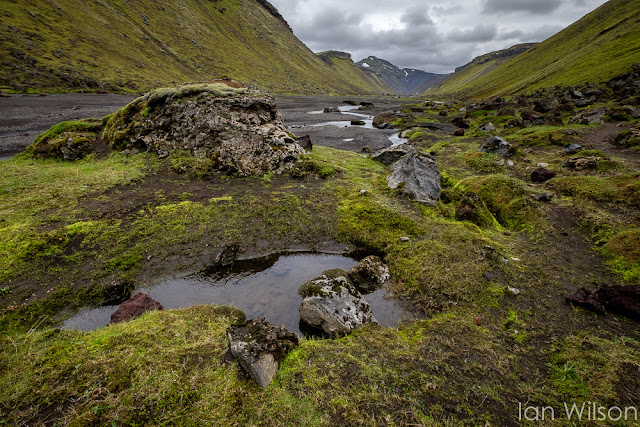Eldgjá is an enormous volcanic fissure, formed in the year 934, which is 8km long, 400m wide and 150m deep. It is part of a much larger eruptive fissure - over 75km long - which extends all the way to the Katla volcano. Eldgjá itself is part of the Vatnajökull national park, and as such it is looked after by resident park rangers during the summer months. There were two there when we visited, and they told us it had rained every day since they arrived.
It was raining on the day we visited too, but there was a break in the clouds so we decided to walk up the valley to have a look at the waterfall. Before doing so we investigated one of the many volcanic vents in the area, which turned out to be pretty deep with snow at the bottom.
The valley started off fairly wide, but with very steep sides. It began to narrow as we approached the waterfall, and there was evidence of volcanic activity absolutely everywhere. This included the same bright red "house brick" formation we had observed when visiting Krafla.
Eventually we reached the waterfall, which was well worth the effort expended in getting there. Some hardy souls decided to cross the river and climb up the waterfall itself, but since we still had quite a distance to drive we decided to stay on the valley floor. The views were still pretty good, and enhanced by the dark, brooding sky.
I had just enough time to take a handful of "big stopper" shots, which had the inevitable effect of smoothing both the water and the sky. My feeling is that the filter has actually removed some of the menace from the location, so on the whole I prefer the unfiltered shots in this instance. I'm sure other people will disagree, however.
It was a very long, hard and bumpy drive across as we headed towards the coast, and there were far more rivers to ford than we'd met when crossing the Sprengisandur. Eventually, as we descended off the highlands, we could see that it was very hazy in the distance - the effect of a sandstorm over the Skeiðarársandur. At Grof we found a small church with a graveyard, and it was mandatory to stop and have a look. There was no time to go inside, unfortunately.
By now we had hit "brown" roads (normal, gravel tracks which can be used by all car types), which showed that we were getting close to civilisation. It wasn't long before we were driving on "red" roads (with the luxury of tarmac), and very soon we had joined route 1 just west of Kirkjubæjarklaustur. That was the end of our serious highland driving experience, and it was something I wouldn't have missed for the world.





















No comments:
Post a Comment